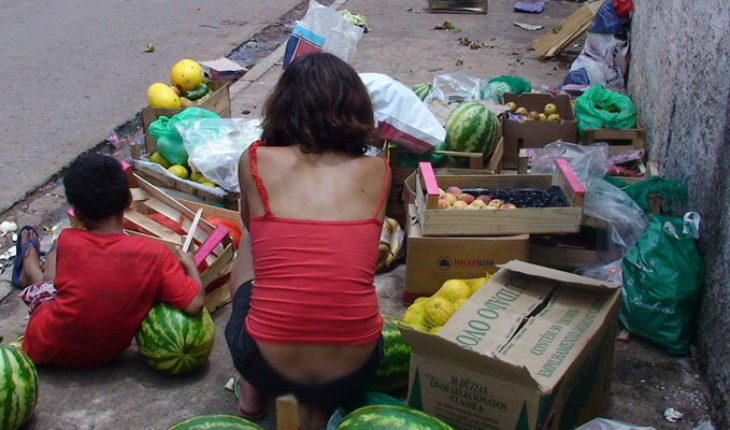city of Mexico.-three-year-old Juan Alfredo knows perfectly what is hunger. Like his five brothers, he eats only once a day and does it at home, but in a community dining room attended Monday through Friday.
In an article published in Conacyt and written by Ana Luisa Guerrero, they reported that they live in the community of San Juan Tlihuaca, at Villa Nicolas Romero, and part of the 6.6 percent of the population in extreme poverty, living in this municipality of the State of Mexico how the National Council of evaluation of the policy for Social Development (Coneval) identified it in 2010.
For three pesos, these children take to the mouth a dish of soup, rice or beans, a stew and fruit water. If it were not for the dining room of charity – sponsored by a religious order of Franciscan-hard they would prove food daily.
The reality of Juan Alfredo is a constant in the country. According to the national survey of income and expenditure in the households (ENIGH), in 2016, almost one-third of the Mexican families had difficulties to meet their food needs. Of them, 28 per cent had a, child or adolescent who ate less than what is owed; the proportion was higher in States like Tabasco, Oaxaca, Michoacán, Guerrero, and Sinaloa.
These indicators of the Instituto Nacional de Estadística y Geografía (Inegi) show that 42.2 percent of Mexican households said to have had concern that food was over them, while in 11.8 per cent were left without eating.
Food is one of the main problems facing humanity. Worldwide, 815 million people suffer from hunger, according to the United Nations Organization for food and Agriculture (FAO, for its acronym in English).
In contrast, food would be sufficient to feed the world’s population total is produced on the planet, but the loss and waste represent almost a third of the food which is produced, equivalent to thousand 300 million tons, of agreement data of FAO; therefore to reduce hunger is one of the challenges of the 2030 Agenda to which the members of the Organization of the United Nations (UN) have committed.
In developed countries of Europe, as well as United States, Japan, China and Australia, the largest waste of food is given in distribution and, particularly in the consumer, since you buy more than you can eat. While in countries with low income, the loss arises in all levels of the chain due to lack of infrastructure, outdated technology and lack of resources to invest in production.
Mexico, waste that lacera if in the country the loss of food at different levels of the chain, the 50.8 million Mexicans that to date they can not buy the least essential to live, is retarded would have food on your table every day.
Inside and outside of the household food consumption analysis quantified the magnitude of waste in Mexico for the first time. Was counted the loss of 20.4 million tons of food a year, equivalent to 34 percent of the national production, explains Dr. Genaro Aguilar Gutierrez, researcher at the school of Economics of the Institute Polytechnic national (IPN) and who He was Secretary of the technical group of food losses, and losses charged to carry out this measurement.
“When we begin to see the availability of food, we realized is that there is enough food to feed the entire population, and that is no way to have them available;” However, a large part of the production is lost,”says to the Conacyt information agency.
The study – carried out in coordination with the Ministry of Social Development – consisted of the application of a mathematical model using three variables: how much of the national production is exported, how much you care and how much is consumed in the country.
Therefore they used data from the national survey of income and expenditure in households, in the Secretariat of agriculture, livestock, Rural Development, fishing and food (Sagarpa), the Secretariat of Social Development (Sedesol) and the Ministry of economy.
Funded by the call for projects of scientific development to address problems national, of the National Council of science and technology (Conacyt), identified that if those wasted food are met, it would be possible to deliver weekly to the poorest families an integrated food basket of four kilograms of meat, 3.8 kilos of chicken, 16 litres of milk, 15 kilos of tortillas and two kilograms of mango, with which these people could get out of the category of food poverty.
The national researcher further emphasizes the environmental impact that brings with it the waste, since unnecessary carbon dioxide (CO2) emissions are generated and may be equivalent to almost 15 million car annual emissions, about the vehicles circulating in the States of Mexico, Jalisco, Nuevo León and the city of Mexico.
While natural resources are lost as water and soil, to produce foods that end up in the trash.
“If it attacks the problem of food waste, at the same time it is complying with one of the objectives of sustainable development 2030, less impact on the emissions of dioxide of carbon into the atmosphere”, adds.
In economic terms, the impact was recorded at more than 400 billion pesos per year, equivalent to more than twice the annual budgets of the Sagarpa and Sedesol.
Source: Conacyt
translated from Spanish: Strives it to reduce the waste of food in Mexico
September 7, 2018 |





